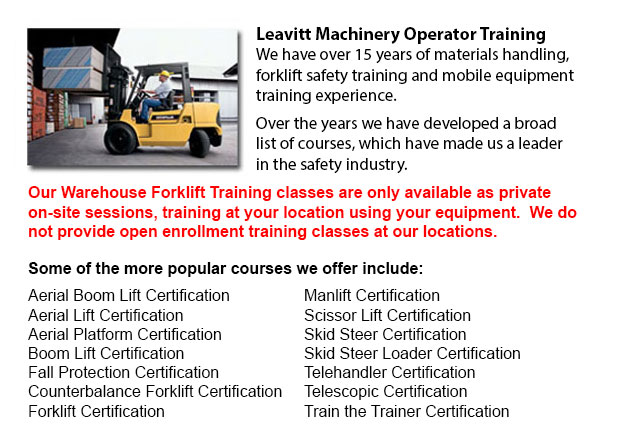
Warehouse Forklift Training Programs Kelowna - Warehouses can either be retail, industrial or commercial facilities, functioning from product distribution services to bulk product retailing. Regardless of the type of warehouse, staff inside warehouse settings should be well trained in safety procedures related to material storage and handling, loading docks, conveyor systems, and forklifts and pallet jacks. Good housekeeping is vital to an orderly and safe warehouse setting.
The loading dock system is often build into the warehouse at a height from the ground making it easy to move items coming in and moving out of the warehouse. Personnel will likewise unload and load merchandise and materials from the ramps and elevated docks. Particular attention should be paid to safety habits during this stage. To be able to prevent falls, install yellow striping along the edge of docks and ramps. Pay attention to the area all-around delivery trucks that are parked at the loading dock, particularly the part between truck and dock. Be certain that when unloading, truck wheels are chocked.
Some warehouses make use of conveyor systems to distribute products inside the facility. Conveyor systems have moving belts and wheels that pose a pinch point danger. Keep parts of the body and hair well away from conveyors to prevent injury. Elevated conveyors pose a hazard to staff below if safety nets are absent. Workers should know how to stop conveyors in case of emergency. Be aware of the location of emergency stop buttons and off switches. When servicing conveyors, lock out/tag out procedures are mandatory.
Forklifts and pallet jacks are designed to move materials around the warehouse. Forklift operators are needed to take training and be given certification. Pallet jack operators do not need certification, but should be trained on the machine. Training courses instruct operators in the correct ways for lifting materials and moving them to their assigned place. Neither pallet jacks nor forklifts must ever be made use of to lift or transport employees.
Rack system and storage shelving help to create an efficient and orderly work space if they are sturdy, braced, and allow enough room for individuals and machines to pass. Careful and slow placement of good is needed to prevent accidents caused by products falling off the facing aisle. Aisles must be kept clear by keeping products flat and inside the shelving units. Pallets are used for stacking products. They should be in good condition, and palleted products should be shrink-wrapped or baled, whenever possible.
Personal protective equipment (or likewise known as PPE) must be worn, as appropriate, to protect workers' limbs, heads, feet and hands. Hard hats or bump caps, gloves and steel-toed shoes are common PPE.
Slippery floors that are pocked with pits and dents may present significant hazards, making good housekeeping really vital. Warehouse docks and floors must be clear of oil, dirt and debris. The space should be kept clear of garbage, boxes and baling materials.
-
Counterbalance Forklift License Kelowna
Counterbalance Forklift License Kelowna - Forklifts, when operated by completely trained workers, are a major advantage to companies. We offer a thorough training program consisting of all parts of operating a powered lift device. Counterbalance fork... More -
Forklift Certification Schools Kelowna
Forklift Certification Schools Kelowna - Within North America, forklift certification is mandatory, making forklift training programs important for both the company and their employees working as forklift operators. Forklift training focuses on healt... More -
Manlift Operator Certification Kelowna
Manlift Operator Certification Kelowna - We provide a scissor platform and aerial lift training and certification to empower the trainee with the general understanding and knowledge of the safe and efficient utilization of "Power Operated Mobile Work... More -
Crane Training Schools Kelowna
Crane Training Schools Kelowna - We have designed several programs for Mobile Crane Operation at our Crane Training Schools. These programs are recommended for the experienced operator who requires re-certification or certification, and for inexperie... More -
Heavy Equipment Operator Classes Kelowna
Heavy Equipment Operator Classes Kelowna - A heavy equipment operator is a person who has received the proper training to operate a particular type or piece of machine. There are a lot of ways for the operator to undergo training and certification in... More -
Telehandler, Rotational Telehandler, Zoom Boom Training in Kelowna
Telehandlers or also known as Telescopic handlers are really popular piece of heavy construction equipment normally utilized in agriculture and construction trades. These equipments have extreme reaching capability and could get to places where a tra... More -
Zoom Boom Training Kelowna
Zoom Boom Training Kelowna - Zoom Boom Training is intended to train operators on variable reach forklifts. The goals of the training are to impart an understanding of the physics of the equipment, and to outline the operator's tasks. This course fol... More -
Boom Lift Safety Training Kelowna
Boom Lift Safey Training Kelowna - Boom lifts fall under the type of elevated work platform or aerial lifting device. Most normally utilized in construction, industry, and warehousing; the boom lift is so versatile that it can be utilized in almost w... More

Forklift Training Kelowna
TOLL FREE: 1-888-254-6157
Kelowna, British Columbia
forklifttraininginkelowna.com
Email Us
About Us


